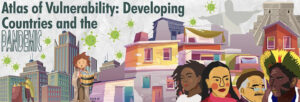
NEW YORK — Just in time for the convening of world leaders at the G20 Summit in Rome, two advocacy organizations on Oct. 25 launched a database that illuminates existing vulnerabilities and growing challenges developing nations face due to the COVID-19 pandemic.
The Atlas of Vulnerability: Developing Countries and the Pandemic database features 24 Latin American and Caribbean countries that Eric LeCompte, executive director of Jubilee USA Network, argues need more support, resources, and aid than they’ve received so far through the COVID-19 pandemic.
Releasing it now, he hopes, portrays that reality to G20 leaders as they come together this week.
“These are really unfortunate, really challenging findings that we hope motivates world leaders to act,” LeCompte told The Tablet. “This data is going to make it possible for world leaders to see that these developing middle-income countries need to be included in aid and financing, and need to be included in more vaccine distribution policies.”
LeCompte also acknowledged the significance of launching the database ahead of the meeting between President Joe Biden and Pope Francis on Oct. 29, where these issues will be discussed. The Biden administration has been a world leader by committing to donating over 1.1 billion COVID-19 vaccines to low- and middle-income countries. Pope Francis, meanwhile, has long called for equitable vaccine distribution worldwide.
The challenge in getting aid to these nations from the onset of the pandemic, LeCompte noted, is the World Bank’s method of determining if a country is low, middle, or high income that uses the average income of the population without taking into account the country’s wealth and income disparities. As a result, countries like Haiti, for example, are considered middle-income countries and are not privy to the same level of international aid as poor countries.
The World Bank re-designated Haiti this summer as a low-middle income country from its previous designation as a low-income country, noting that Haiti “has published an improved series of national accounts statistics in July 2020, with revised GDP (Gross Domestic Product) substantially higher than previously published.”
Patricia Miranda, global advocacy director of the Latin American Network on Debt, Development and Rights (LATINDADD) that launched the new database in conjunction with Jubilee USA Network — a coalition of religious, development, and advocacy groups that focuses on policies that help end poverty worldwide — said the new database looks beyond designations.
“Our map brings together the whole range of economic, social and climate weaknesses that cripple pandemic response in developing countries,” Miranda said. “The result of the research overcomes artificial categories of developing low- or middle-income countries.”
She added that “in Latin America, middle-income countries are the majority and were left out by global recovery policies.”
The database is set up in the form of an interactive map. A toggle menu drops down into twelve categories for the user to explore for each country: external sector, fiscal sector, private sector, health system preparedness, education, employment and social protection, food and nutrition, climate, gender, poverty, inequality, physiological conditions, and debt and fiscal balance.
After a category is chosen, a second dropdown menu contains subcategories. From there, the database displays a list of the countries in order of most affected by that subcategory.
For example, if a user toggles the dropdown menus to the poverty category and the extreme poverty subcategory, the database shows the countries with the highest percentage of the population living in extreme poverty. The top five are Honduras (41.7%), Guatemala (23.4%), Mexico (16.8%), Ecuador (15.4%), and Colombia (15.1%).
Another category-subcategory combination is employment and social protection and unemployment, which shows that Panama (18.6%), Costa Rica (17.4%), Colombia (15%), Haiti (14.1%), and Brazil (13.7%) have the highest percentage of the population unemployed.
There are about 60 subcategories. Others include access to education/schooling, income and wealth inequality, climate response capacity, excess mortality and access to vaccines.
From the lists the database generates, a user can also hover over a specific country to see its top five vulnerabilities. Haiti’s, for instance, are dietary adequacy, climate response capacity, public health spending, access to vaccines (reported as 0%, meaning no one in the country is fully vaccinated) and its lack of physicians.
Haiti has been riddled with turmoil through 2021, especially in recent months with the assassination of the country’s president Jovenel Moïse in July, a 7.2 magnitude earthquake in August, and gangs overtaking parts of the country amid the political instability.
White House National Security Advisor Jake Sullivan on Oct. 26 said Haiti will be a topic of conversation at the G20, and acknowledged that the United States and other countries have to step up to provide the international aid it requires.
LeCompte hopes the G20 leaders will step up to provide much needed aid to not just Haiti, but the other 23 developing Latin American and Caribbean nations. If not, he said, the United States and Europe will continue to experience their own economic challenges.
“It’s going to be important for us to realize that if we don’t deal with the problems of these countries, not only will people continue to suffer, but we will continue to deal with economic shocks in the United States and Europe as well,” LeCompte said.
